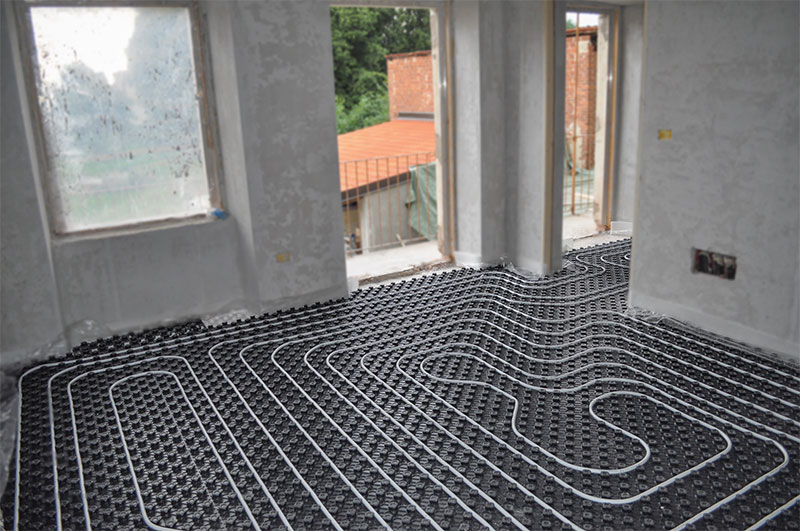As cooler weather sets in, homeowners rely on their heating systems to keep their homes comfortable and energy-efficient. Among the many heating options available, radiant floor heating has become increasingly popular for its ability to deliver even, consistent warmth.
If you’re considering radiant heating, the choice often comes down to electric vs. hydronic systems. Here’s what you need to know to make the best decision.
What is Radiant Floor Heating?
Radiant floor heating is a system installed beneath your flooring that uses either electric cables or hydronic (water-based) tubing to warm a space. Heat radiates upward, providing even, consistent heating that eliminates cold spots and drafts typically associated with forced-air systems.
Electric Radiant Heating
Electric radiant floor heating is a wired system connected to your home’s electrical panel. These systems use thin electrical cables, which can be installed loose with a Membrane system or as a mat system, which has cables pre-spaced and embedded on mesh.
Hydronic Radiant Heating
Hydronic systems use flexible PEX tubing under the floor, connected to a boiler that heats water to circulate through the pipes. These systems are more complex to install but are highly cost-effective for heating larger spaces, particularly in colder climates.
Electric vs Hydronic Radiant Floor Heating
While both systems use radiant heat to provide effective heating, the similarities end there. Each type of system – both electric and hydronic – has its advantages and disadvantages to consider.
Efficiency
Electric systems are faster to heat up, making them ideal for areas where quick, on-demand heating is needed, such as bathrooms or kitchens. They also integrate seamlessly with smart thermostats like Warmup’s 6iE Smart WiFi Thermostat, allowing you to schedule heating, monitor energy usage, and optimize efficiency.
Hydronic systems are more efficient for continuous heating in larger spaces, but their slower heat-up times and reliance on a boiler make them less practical for smaller spaces or homes with high heat loss.
Main vs. Supplemental Heat
Both types of systems are capable of being a primary heat source under the right conditions. To determine if this is a possibility for your home, you must consider how much heat loss your home has. Older homes typically have less insulation, resulting in more significant heat loss.
Finding out the heat loss calculations in your home can help in determining if an underfloor radiant heating system can output enough heat to make up for the heat loss or if it would work better as a supplemental heat source.
Installing it as a supplemental heat source can allow your main system to run at lower temperatures, which can help lower utility costs while keeping your home at the perfect temperature.
Maintenance
Maintenance is another factor to consider. These systems, once installed, are virtually unseen; if the system is damaged or needs maintenance under the surface of the floor, you may not know immediately. This makes proper installation vital, as fixing an issue under the floor once the installation is complete can be difficult.
- Electric Systems: Require little to no maintenance if installed correctly, making them a low-maintenance choice for most homeowners.
- Hydronic Systems: Require annual boiler tune-ups ($400 to $500) and occasional repairs. Contrary to common belief, leaks typically only require localized pipe repairs rather than full system replacement.
Installation Costs: Electric vs. Hydronic
When evaluating the costs of electric versus hydronic radiant floor heating, it’s important to break down the key components that influence pricing, from materials and labor to flooring and long-term operating expenses.
Material Costs
Here’s a breakdown of material costs for both electric and hydronic radiant heating systems:
Electric Radiant Heating
- DCM-PRO Cable: For 35 sqft of heated area, the cost is approximately $925.
- StickyMat System: An area of similar size costs $780.
- Thermostats: Warmup’s Smart Thermostats range from $252 to $298.
Hydronic Radiant Heating
- PEX Tubing: $7 to $22 per square foot.
- Boiler: Costs range from $3,200 to $9,000.
Labor Costs
Both electric and hydronic radiant floor heating systems require professional installation for certain components, which can significantly influence overall costs. Here’s a closer look at the labor involved for each system:
Hydronic Systems
Plumbing costs range from $45 to $200 per hour, with installation taking 4–8 hours for a small space or several days for larger areas.
Electric Systems
While many components can be DIY-installed, electrical work should be handled by a professional ($50 to $100 per hour), with installation taking 4–6 hours for a small area.
Type of Flooring
The type of flooring you choose can also affect the cost. Tile flooring costs the most, however, tile pairs well with radiant heating and can help the system heat more effectively.
Laminate and hardwood are other popular options. These types of floorings are best with electric systems because, with hydronic systems, if the system develops a leak, it could lead to mold and rotting.
Flooring installation can cost between $4 to $15 per square foot. The amount of time it takes to install the system will depend on the size of the room, the type of flooring, and if you requested a unique pattern, like herringbone.
Operating Costs
For any system, there are costs to consider after the installation is complete. Operating cost is among the most significant deciding factors for many homeowners when choosing a heating system.
Electric Systems
For a 1,500 sq ft home running the system for approximately 4 hours a day, the operating cost would range from $90 to $250 per month.
Hydronic Systems
Operating a hydronic system in a 1,500 sq ft home for around 4 hours daily could cost between $65 and $165 per month.
Why Warmup’s Electric Systems Stand Out
Warmup’s electric radiant heating systems offer several key advantages:
- Flexibility: Perfect for remodels, small spaces, or supplemental heating.
- Smart Controls: Warmup’s Smart Thermostats optimize efficiency and give you complete control over your heating system, saving energy and money.
- Ease of Installation: With options like the StickyMat and DCM-PRO System, Warmup systems are easy to install and integrate seamlessly with a variety of flooring types.
- Durability: Designed for long-lasting performance with minimal maintenance required.
Heating Your Home With Radiant Heating
Radiant floor heating is an efficient and reliable solution for creating a warm, comfortable home. Electric radiant heating systems stand out for their versatility, quick heat-up times, and ease of installation.
While hydronic systems can be effective for larger, continuous heating applications, they come with higher installation complexity and maintenance costs.
Contact Warmup today to learn more or get a quote for your next project and take the first step toward transforming your space with radiant floor heating!





![Thumbnail [200x250]](/wp-content/uploads/Indoor-Systems-Page-Image.png)
![Thumbnail [200x250]](/wp-content/uploads/image-13.png)
![Thumbnail [200x250]](/wp-content/uploads/Projects-Image.png)